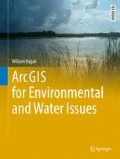Abstract
The second type of spatial data that is used in GIS is the raster format, which is one form of organization for spatial data. This type of format is suitable for continuous surfaces, such as temperature. Raster is a regular grid of mesh of cells (pixels) that laid over the landscape covering a specific area. The cells of the grid are organized in rows and columns.
Access this chapter
Tax calculation will be finalised at checkout
Purchases are for personal use only
Author information
Authors and Affiliations
Electronic Supplementary Material
Rights and permissions
Copyright information
© 2018 Springer International Publishing AG
About this chapter
Cite this chapter
Bajjali, W. (2018). Working with Raster. In: ArcGIS for Environmental and Water Issues. Springer Textbooks in Earth Sciences, Geography and Environment. Springer, Cham. https://doi.org/10.1007/978-3-319-61158-7_12
Download citation
DOI: https://doi.org/10.1007/978-3-319-61158-7_12
Publisher Name: Springer, Cham
Print ISBN: 978-3-319-61157-0
Online ISBN: 978-3-319-61158-7
eBook Packages: Earth and Environmental ScienceEarth and Environmental Science (R0)

